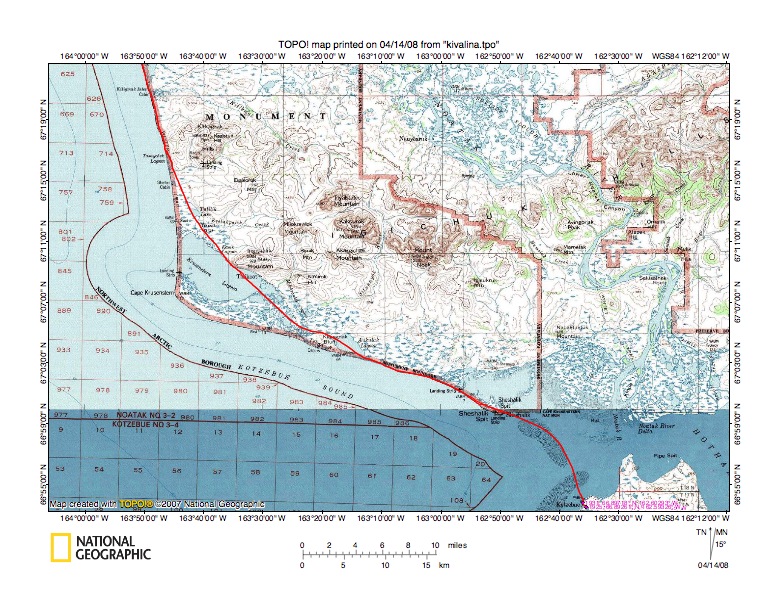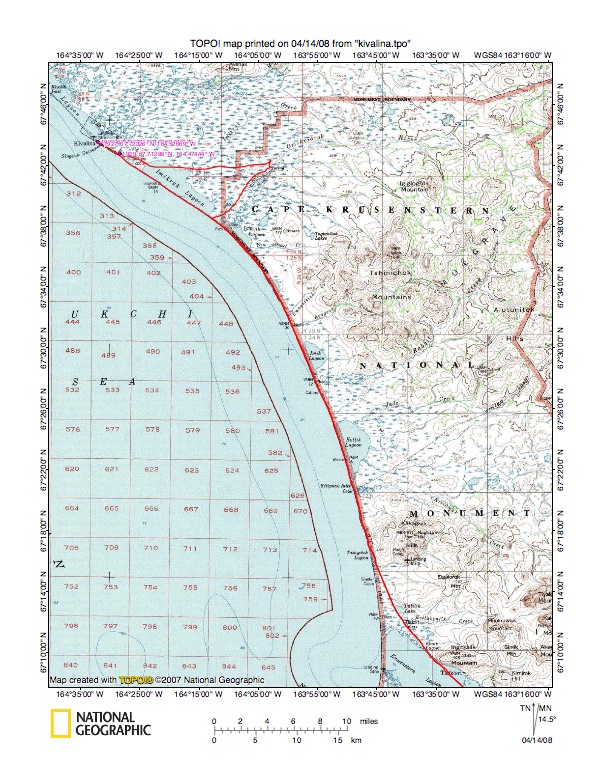Spring Campaign final preparation

We have exciting news for the permafrost monitoring program. We will start
drilling and lecturing along the Bering Sea coiastal region, from Emmonak to
Kotzebue next Sunday, March 16th. You will be able to see “what is going on
with us ?” everyday at our website www.uaf.edu/permafrost .
Our detailed schedule depends on weather, trail conditions, how the drill
machine works, etc. It will be hard say when we are where?!
However, If you check our blog. You can find out where we are! And see a lot
of pictures!
Any questions? You can reach us via E-mail (ffky@uaf.edu).
Anivik March 14
Shageruk March 15
Bethel March 16
Emmonak March 17
Kotlik March 17
St Micheal, March 18
Stebbins March 18
Unalakleet March 19
Shaktoolik March 20
Koyuk March 21
Elim March 21
Golovin March 24
White Mountain March 25
Nome March 25
Teller March 26
Brevig Mission March 26
Wales March 27
Shishmaref March 28
Deering March 30
Kotzebue April 1
Bethel to Emmonak



In Bethel Kenji was joined by Ned and Tohru.
Since it has been snowing.
There were worries that the flight will be canceled to Emmonak.
Even with concerns, we had a great time thanks to Ron and Kathy's warm
welcome.
(Kenji's old friends)
The flight out of Bethel was almost like being trapped inside a ping pong
ball.
All white...
Just at the end of the flight, we were able to see the blue sky and the
village of Emmonak.
And a lot of moose tracks around the airport.
As soon as we landed we were ready to pack our snow machines and start
drilling.
Unfortunately we soon found out that some of our gear were missing, still in
Anchorage.
THe Science teacher, Will came to meet us at the airport.
Will brought a truck and took us to the gas station to get gas for our snow
machines before the store closed.



After some looking around, Kenji found a suitable spot for a Permafrost
station and started drilling.
Despite the lack of some equipment, a 3.5 meter bore hole was drilled and the
sensors placed in the casing.
A successful Frost tube monitoring station installation soon followed.



Thanks to the long daylight we were able to finish a lot of work before dark.
Ron showed us the trail that leads to Kotlik.
The trail that we will be heading out on tomorrow.

After having a burger at the restaurant, a rarity in the village, we unpacked
and reorganized our gear, and also pre made some of the Frost tubes.

A full morning in Emmonak


It was a long night making final preparations for the trip.
We were able to stay at the school last night.
Waiting in the classroom as the students started coming into the building.

Kenji talked to the students in the gym,
and talked about the Permafrost station and the temperature of the ground
around the school.
After the talk, we found out that the sleds will not arrive here today.
It was a completely disappointing news that could change the entire schedule.

Since we don't have the casing pipes either, we used plastic containers
Scrambling to look for the best solution, calling the freight company and VECO.
Hours went by...
Kenji went to the river to take some samples and measure the ice thickness.

While we are thinking about our next move, Ned was asked to give a talk to the
students.
And new development with the sled.
We may borrow a sled from the locals...
for more information try
http://www.iarc.uaf.edu/expeditions/
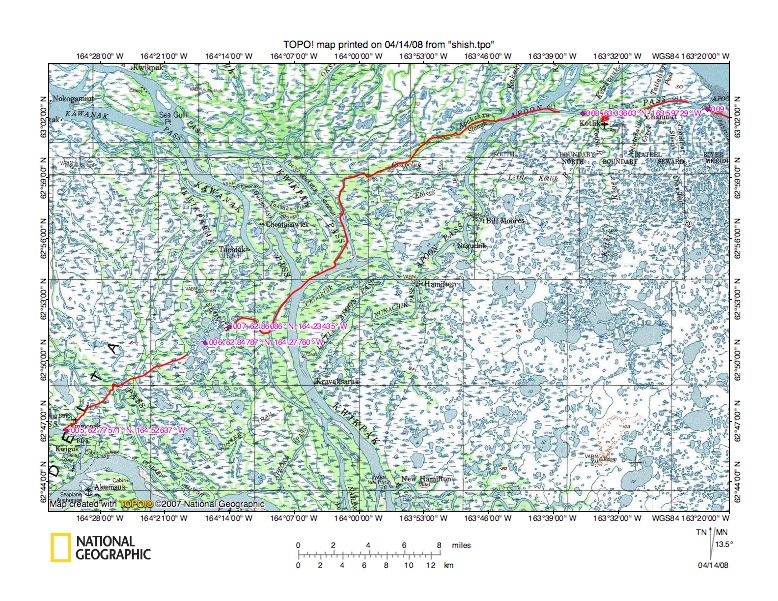
Kotlik and Stebbins
We thought of a few options last night.
But nothing was certain until morning.

Once calls were made and talked to some people, we decided to send some of our
equipment in Emmonak and our sleds in Anchorage to Unakleet.
The stuff will get there on Thursday, and if we hurry we can be there when it
arrives.
To do this, we needed to lighten our load, because we were only able to find
one sled that would work for us.
Unfortunately the other sleds in the village sold out just days ago.

Although everything was in a rush, we were able to pack and leave by 10:30.
Since we had been delayed, we were planning on making a quick stop at Kotlik
and then arriving to Stebbins or St. Michels today.


(Special thanks to Jason who loaned us his sled and Will who helped us with
everything)

The trail was nice and hard and well marked with a little bit of fresh blown
snow.
There was enough tracks from Emmonak to Kotlik, and it only took about an hour
and a half to get there.
As soon as we got the school, Kenji talked to the teacher and we started
drilling the hole for the Permafrost station.
Although the wind was blowing a little bit, the drilling went successfully.


After fueling up, we headed to Stebbins.
despite the cold wind, the clear blue sky made for a good day to travel.
We even took a short break for lunch.

Along the coast it became harder to see where the land ended and the sea
started, very flat and hard to tell directions and distances.
Three hours on the snow machine and we made it to Stebbins around 6 PM.
Thanks to Eric the school door was open for us.
We quickly drilled a hole for the Frost tube and called it good for the day.

St Micahel
Yesterday Kenji talked to the students first thing in the morning.
It was a cold morning with some wind.
Then we drilled the borehole for the permafrost station.
When it's cold many things can go wrong.
The bit, the adapter for the auger, plastic casing etc.
The biggest problem was the adapter, but we managed to successfully get the
job done.
From Stebbins to St. Michael is only about 12 miles.
A quick hop compared to the other locations.
We got there in the afternoon.
We started drilling there but the adapter had more problems...
Although we finished drilling and set the permafrost station and the frost
tube.
It will be challenge to drill with our current equipment.
Especially with the cold temperature right now.
(-18F)
We will head to Unalkleet around 10:30 this morning.

Unalakeet
Another busy morning for Kenji at St. Michael.
We stayed Frank's science class last night.
His talk started at 9:30 and as soon as he was done, he went to the Permafrost
Station to download the data.



The trail to Unalakeet is less traveled and Kenji was a little cautious about
the trail.
But we asked for trail conditions and markers from many of the knowledgeable
people.
And luckily, there were 7 dog teams and snow machines that went on the trail
two days ago, so the trail should be easy to find.
The temperature in St. Michael was -17F with some wind.
We were prepared for a cold ride.

Soon we were out of the cold area, and the felt much warmer with the sun
shining high above us in the blue sky.
The trail was in superb condition.


We saw the group of mushers in Golsovia.
Again, we got more information about the trail ahead of us, which is even less
traveled.
There were some known open water in he area, so we wanted to be sure where to
get out on to the sea ice.

As we got closer to Unalakleet the near shore ice became harder to ravel with
all the jagged mounds of land fast ice.
There were also a lot of drift wood in this area.

We stopped at the school first and talked to the principal Bill.
Even though it was during Spring Break, he was kind enough to let us say at
the school.
A beautiful day snow machining, safely arriving in Unalakleet, getting a place
to stay, it almost seemed like our first good day.



But that didn't quite work out the way we hoped to.

When we went to pick up our cargo, we were told that it wasn't here yet...
We were counting on our sleds and other gear to continue our installation
expedition.
Kenji starts thinking and trying to figure out what he can do.
Supply is hard to come by in the villages, and here is no exception.
He scrambled around the village to look for some pipes...
After some phone calls, he finally found some 1"1/2 ABS pipe.
Know it's improvising time.

One good thing about this trip is the beautiful sunset we have been having.
As the sun is setting Kenji is drilling the sea ice to measure the thickness
of the ice.
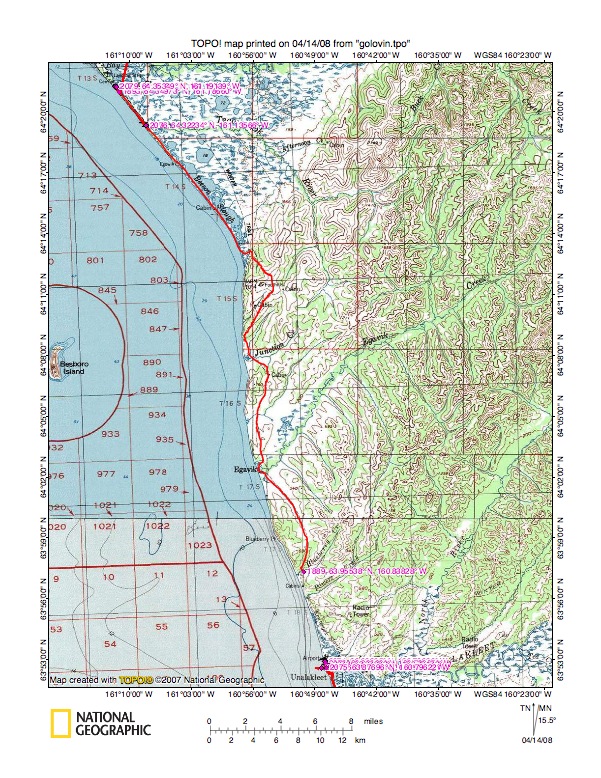
Shaktoolik
What a day!
Another memorable arctic travelling.

Since the Unalakleet school was in Spring Break, the morning was rather quiet.
We are always thankful for the hospitality we receive and enjoy talking to
people from that area.
But in reality the situation was far form being calm.
Kenji was trying very hard to gather all he could to keep this expedition
together.
With the additional rigid plastic pipes he was able to gather, the sled became
precariously long with a few feet of pipes hanging from the back.



From Unalakleet, the trail is an overland trail with many great vantage points
along the way.



We were able to enjoy the great view of parts of the western coast of Alaska.
The ice free area wer noticably colored in dark blue compared to the otherwise
flat and white sea ice.
It was also comforting to see trees along the trail, instead being in the
middle of a baren wind howling hills or sea ice.



The trail markers from the Iditarod were still visible along the way, which
helped us find our way through some treacherous parts which came rather
abruptly and unexpectedly as we descended the last hill that opend to a flat
area that leads to Shaktoolik.

Strong cold wind was balsting into our face, picking up snow and blowing
accross the surface of the snow.
Even the well travelled Iditarod trail was sometimes hard to see without the
markers.
There was small hope that Shaktoolik would be in sheltered area compared to
where we were going through.
But of course that was not the case.

At the Shaktoolik school we asked how long the weahter has been this bad. They
all said "It's always like this".
Sure enough, a lot of the people were in their thin looking jackets.
But at least covering there ears.
The fed us some Arctic Char for lunch.
Kenji gave a short intorduction about the permafrost monitoring project and
talked about Permafrost related isses to the middle school students.



After that, we braved the weather and went drilling to install the monitoring
station.
It is usually hard enough when the temperature is low. Adding strong wind to
the equation makes it even more difficult to make things work.
With diligence and tramendous hard work, Kenji was able to install another
monitoring station.



We plan to leave for Koyuk tomorrow.
And the locals say that is's usually even windier from here to there.
It is quite amazing to think about the mushers and dogs who run the Iditarod
race on this trail, and also the tough people who lives here.
They do have amazing sunsets though...

On a much happier note, Today was Ned's birthday.
Amazingly enough, he was here 10 years ago on the same exact day, sleeping in
the same school and classroom.
We celebrated with Napoleon icecream.


Koyuk
Another permafrost station and frost tube station was added to the Permafrost
Outreach network.
But it wasn't an easy one.
The morning at Shaktoolik was quiet since it was a Saturday and the kids
didn't come in at eight like they do on weekdays.
The clear blue sky was deceiving and almost made it look warm outside.
I guess temperature-wise it wasn't too bad, but the wind would blow away any
heat that you had around you.




So, obviously the trail from Shaktoolik to Koyuk, that runs mostly on sea ice
or flat tundra was completely wind-blown with hard-packed sastrugi everywhere.
Sometimes Kenji's tracks would be erased by the drift before the second person
passed it.
Again, the Iditarod trail markers helped us with our bearings.
The only noticeable structure along this 50 miles was a shelter cabin about 15
miles from Shaktoolik.

Other than that, it was a very white and cold ride until the very end.
Even in Koyuk there was still some wind, but much more tolerable.

At the school, the science teacher Joe was awaiting our arrival.
After a short break, we went to work right away.


The frost tube went in quickly with the new drill setup Kenji is using this
year.
Since it looked like the same area had good features for a Permafrost
Monitoring Station, we decided to drill next to the frost tube hole.
The first 80 cm or so was easy. Just like we hoped.



But from there on the drill would get stuck, time after time. When the drill
gets stuck, it's important to keep it moving, even just a little bit, to keep
it from freezing solid to the ground. If it freezes to the ground, as it wants
to do when a cold wind is blowing, it is almost impossible to get it out.
Halfway into the expedition, some of our equipment is showing signs of fatigue
and with more than half of our original gear missing somewhere in Alaska. We
can't afford to break or lose anything.
After two hours of hard work and lot of struggle, we finished the
installation.
We were disappointed we couldn't drill deeper, but with the conditions we had,
it was wise to stop before something broke.
Back in the classroom, Kenji is strategizing plans for the next couple of
days. In Nome, we will have a chance to resupply some of the equipment. Nome
is still a few days off. Until then, we have to continue improvising and be
very careful with how we do things.

After a long day, we saw another gorgeous sunset from the top of the hill.
From there, you can see where the shelter cabin was in the distance, about 30
miles off, and the frozen Koyuk River below us.

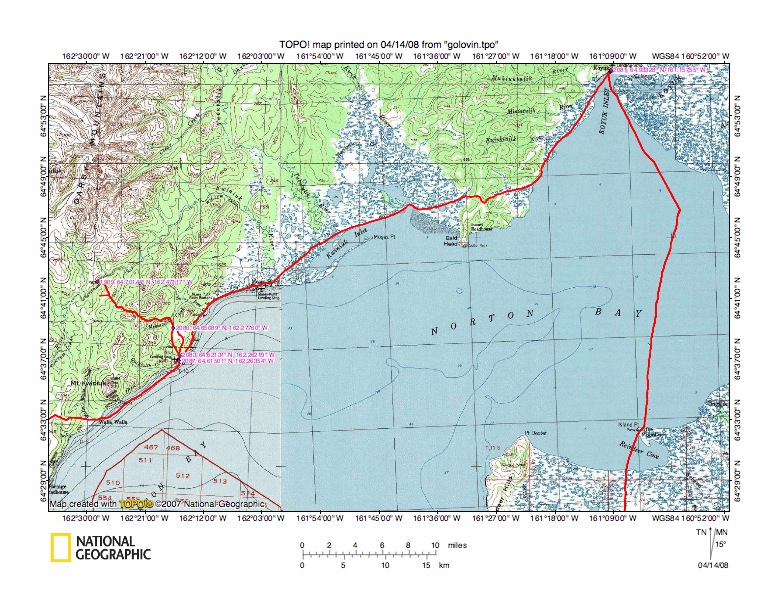
Elim
It's been a week since we started our trip.
So far, we have seven new stations installed.

Today we had another good day of traveling.
We packed our gear and left Koyuk around 10 AM.



The trail was mostly a flat overland trail with some hills that went along the
coast. Large body of open water on Norton Sound could be seen sometimes when
we climbed a hill.

In less than three hours, we were riding into Elim. Since it was Easter
Sunday, a lot of kids were playing outside. The science teacher Mark let us in
the school shortly after we arrived.

Compared to Shaktoolik or Koyuk, this village seems more protected from the
the gnawing north wind.
And the snow was fluffier, unlike the wind-packed hard snow of the past few
days.
On a sunny calm day like this, drilling almost seems easier. First, the frost
tube drilling by the school went well. The permafrost-monitoring station
drilling, on the other hand, ran into a problem less than one meter beneath
the ground surface. It seemed like Kenji's drill hit bedrock, so he had to
back off.


We changed plans and looked for a suitable spot for the monitoring station.
The best spot was inland from the school close to the entrance of another
trail.
Drilling at the new spot went successfully. The new and improved equipment
that Kenji is using this year is working well, and we are actually gettting
better at using the makeshift tubes and plastic pipes for the monitoring
station installation.



We are halfway into our Outreach Expedition and have somehow managed to keep
the schedule on track and successfully install seven stations, but all of this
hard work comes with a price. Especially if your are Kenji and are wrestling
with a 40 pound drill and frozen soil every day.

Whether it was planned or not, we don't now, but Kenji suggested going to the
hot springs.
Hot springs?
Yes! There is a hot spring about 10 miles out of the village!
The trail that winds through the forest and up and over hills was less
traveled but easy to find.
The views from the top of these hills were spectacular.



And the hot spring...

Was great!
What a way to relax and enjoy the evening after a good day's work.

posted from Elim by Tohru
to Golovin and White Mountain
Another full day of activities: a lecture, four holes drilled and travel to
two villages
After explaining to Mark in Elim about the location of monitoring station,
Kenji talked to the students and demonstrated how the frost tube works. We
rode out of Elim by 9:30.



Today was the first day on our trip that felt like Spring. The first half an
hour was a bumpy ride over hardened sastrugi.

Then the trail turned into an overland trail that shortcuts the peninsula. The
trail went over some domes called "Little McKinley." At the top of
the dome, we had a stunning view of the surrounding hills. Then, the trail
drops down. As we descended a long hill, Golovin could be spotted in the
distance.



We arrived in Golovin around 11:30.

As soon as we arrived, Kenji selected a site for the frost tube and started
drilling. Then we had lunch at the school cafeteria. Chicken nuggets and green
peas. Kenji talked to the students right after lunch.



After the talk, he started drilling a bore hole for the monitoring station.
The site was on the southern side of town.
The material was mostly sand and ice. After a successful 4m drill, our best
yet, the station was installed.



Then we packed our equipment, got on our snowmachines, and headed to White
Mountain. It was a flat 15 miles over mostly sea ice and river. We arrived at
White Mountain about 4 PM.

Kenji went to work right away with the frost tube. But after 70 cm he started
hitting rocks. It was the same in other locations.
Instead of drilling for a monitoring station, we decided to install two frost
tubes in different places.



That evening Jack and Joanne invited us over for some caribou dinner. They
were Ned's friends, from his previous visits to White Mountain.

Tomorrow we are going to Nome, where all of missing stuff should be waiting
for us. In case it doesn't come through, Kenji's got a "Plan B"
ready.
posted by Tohru

Nome
Today we made it to Nome, the place that sounds like "No name".
After Kenji's talk to the students in White Mountain, we did some final
touches with the frost tube and hit the trail.
Nome to Brevig Mission
After bumping into Lance Mackey in the Polar Cafe this morning, just before he
pulled his snow hook to start the All-Alaska Sweepstakes, we snowmachined the
road to Teller from Nome, a total of 71 miles.

On this highway, not plowed in winter, snowmachines float a little better than
trucks. The trail was rough in the middle, busted-up sastrugi, but was smooth
close to Nome and for the last 20 miles into Teller.

On the way, we saw lots of Gold Rush relics, including this dredge and the
house where the dredge people lived while they were mining.

We made it to Teller in a few hours. This graveyard is the high point in the
town, which is on a peninsula surrounded by salt water. Kenji spoke with John
Weemes' science class and kids from almost the entire school who asked him
great questions. Principal Jay rustled us up some grub, and we're mighty
thankful for his hospitality. Tohru had drilled a frost tube while Kenji was
speaking. When Kenji went to drill the permafrost borehole, he found that the
drill didn't work!
With no backup after a logistics messup back in Emmonak, Kenji was bummed.
"If we can't fix the drill, it's the end of the trip," he said. We
moved on to Brevig Mission, just six miles from Teller, and Kenji here tries
to fix the drill. After watching him solve every one of the considerable
problems thrown his way during this trip, Tohru and I had a feeling the drill
would somehow be just fine.

Later that evening, in Brevig Mission:

And so, the trip goes on. Yes! We're getting into a good travel groove now,
and from here it becomes even more interesting, as we attempt to get to Wales,
Shishmaref, Deering and Kotzebue. These sections will all be more challenging
because villagers don't travel them too much. In Kenji we trust.
Here's what we have covered since March 16th, about 470 miles in all:

posted by Ned. for more trip photos, see alaskatracks.com

Wales

Another full day of action for all of us.
The trail from Brevig Mission to Wales was less traveled and obviously less
marked.
The morning started out with packing and getting gas.
While we were getting gas, we were lucky to get information about the trail
condition, especially with the white-out conditions we had in the morning.
It wasn't as windy but felt cold probably down in the single digits.



Kenji safely navigated through the blurry white trail.

Even after a wrong turn, he was quick to correct the course, and we were back
on the trail.

The trail it's self wasn't difficult, but the bumps form the wind packed snow
made the 80 mile trip much longer than we hoped.
Coming down on the north side of the hill suddenly the clouds opened up.
Even more surprising was the lack of the wind.
Looking back, we saw the low hanging greyish clouds over where we came from.
Along the trail we saw a moose, muskox, fox, and a lot of animal tracks,
including a woverine and wolf.



By the time we were about 10 miles out of Wales, Kenji had to hurry to get to
the school before the school was out.
Luckily he made it there before the teachers all left.
We are all a little wore out form the continuous travel, but work comes first.
Kenij went right to drilling.
The frost tube went well, but the monitoring station bore hole kept colapsing
as we drilled and backfilled the hole because the ground material was sand.
Although the depth was not the best result, Wales station is probably one of
the most scenic Permafrost Monitoring Station.



After a successful installation it was almost time for sunset.
There were many signs of people living here from a long time ago.
It's hard to say how old they are, but reminants of whale bone houses, stone
trail markers, and look out places made out of piled rocks (probaably for
marine mamals) all indicated the history of this place.



As the sun goes down past over Little Diomede Island another day comes to an
end.
Tomorrow we will head to Shishimaref.
Drilling in these cold places is taking a toll on the equipment.

posted by Tohru
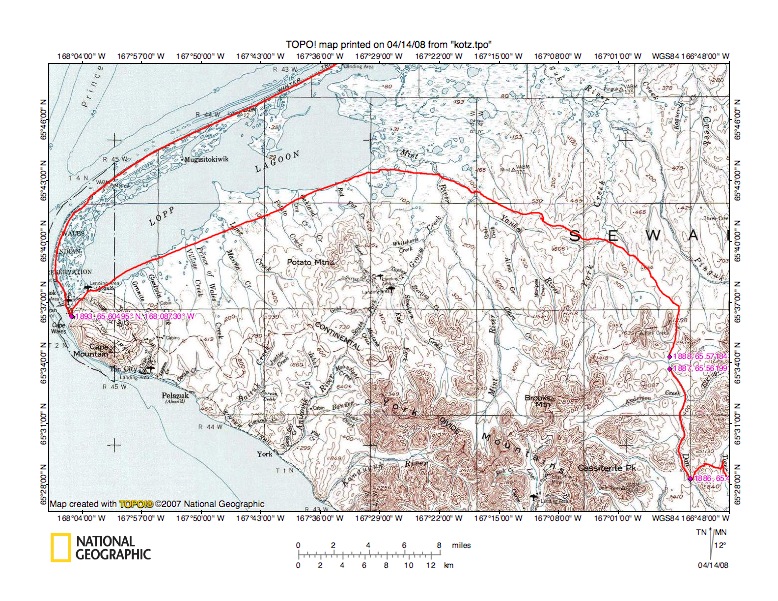
Shishmaref
It was another calm day on the Seward Peninsula.

We started from Wales after Kenji's talk, which was about 10:00.
The trail to Shishmaref is about 80 miles. A flat trail that follows the coast
line.
Weather conditions were great, which made for a good day traveling.
Ear Mountain, land mark of this area, was visible most of the way.



Although it seemed like a cold lifeless landscape, there were signs of life
almost the entire way.
While I spotted some caribou in the distance, Ned found some polar bear
tracks.
For more exciting pictures please visit www.alaskatracks.com



After being bumped around on the snow machine for 6 hours we finally arrived
in Shishmaref.
The village apears in the middle of the white horizon.
The famed erosion was not easy to visualize with the frozen sea.



We did not quite make it to the school before the class was over.
Instead we went straight to drilling.
First the frost tube hole was drilled.
The ground material was sand, similar to how it was in Wales.
Against all odds and failing equipment this Kenji drills to 4 meters.



In Shishimaref Kenji's secret weapon was waiting our arrival. Code name "Kaji"
(a.k.a maru-kaji)
He actually joined us three times during this expedition, and today was his
birthday.
What a way to celebrate your birthday in Shishmaref.

Tomorrow we are heading to Deering.

posted by Tohru
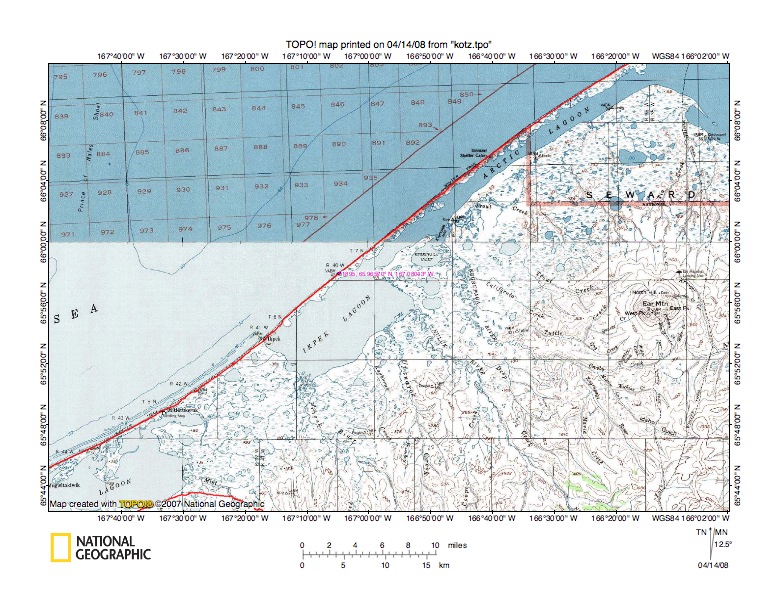
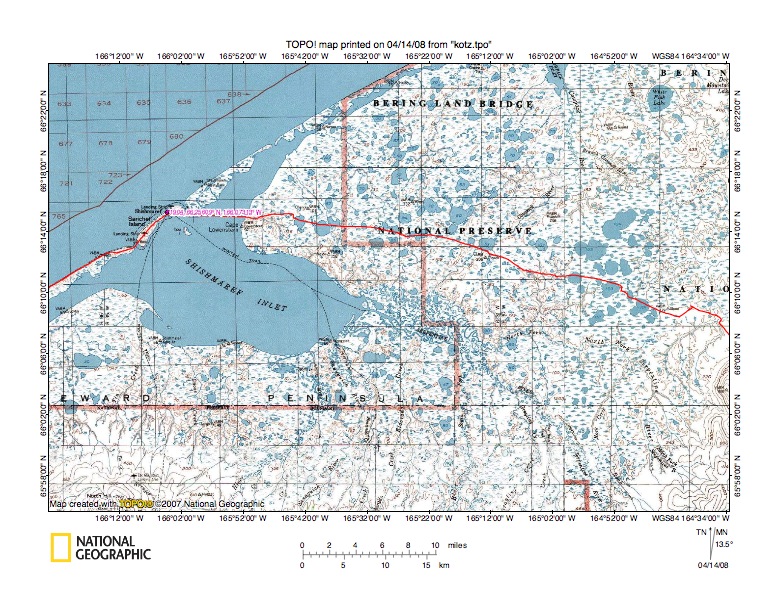
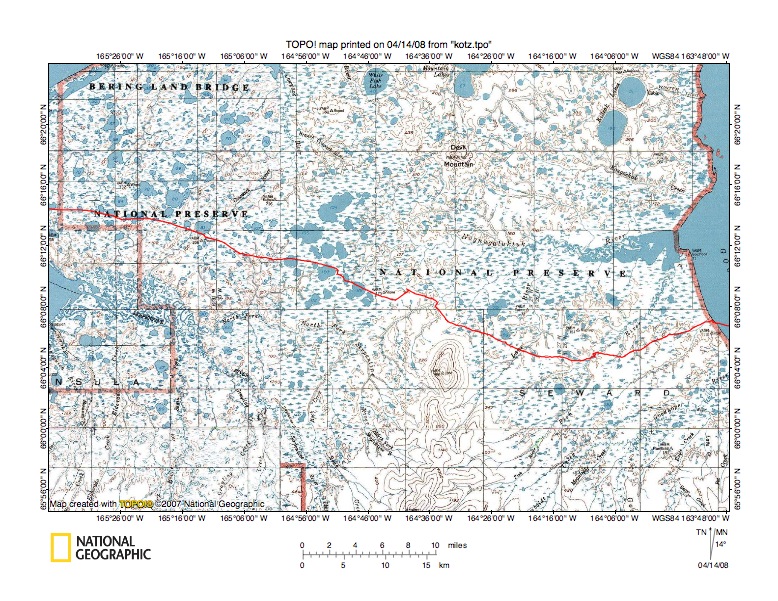
Deering
Another long day on our snow machines
In a straight line the distance is about 100 miles.

After packing and getting gas, The science teacher Ken led us to the trail
head.
We hit the well-marked trail that disappeared into the white landscape across
the lagoon.



Riding in the featureless terrain in the white out condition was somtimes
disorientating, not knowing if you are going up or down.
At least the sun was visible throught the clouds, so it was possible to get
the feeling for the general direction.


Some pingos appeared as small mounds soon after we were on land.
(a closed system pingo... For more information contact Kenji. ffky@uaf.edu)

After some river crossings, refueling, more snowmachineing we made it to
Deering, thaqnks to Kenji's exceptional navigational skills.



The trip took us more than 6 hours.

Eventhough it was Saturday, the pricipal Steve greeted us and let us stay at
the school.
It was a typical open gym night, and people were at the school gym to play
basketball or just watch.

posted by Tohru
Tuesday, April 1, 2008
Kotzebue
Another 100+ miles to Kotzebue from Deering
And another long ride in the whiteout conditions over bumpy sea ice.

After a quick frost tube drill we packed our gear and headed out of Deering.
Last night we got information about the trail condition from a Kotzebue
resident visiting here on the way back from the All Alaska Sweepstakes.



We traveled along the coast out of Deering and passed cabins as landmarks
along the trail.
On the sea ice, the hard sastrugi and drifts were covered with light snow,
making it hard to notice them until the skies on the snow machine hit one of
them, or when your body gets thrown in the air all of a sudden.


Although the trail conditions were rough at times, there were signs of scenic
features.
We also saw musk-ox, caribou, and seals in a distance.




As we neared Kotzebue, the trail was heavily marked, probably for all the
races in this area.

Kotzebue suddenly appeared in the view after coming down a hill.

We stayed at the Fish and Wildlife bunkhouse.
After an early dinner, Kenji went to exchange the data logger form the
Kotzebue monitoring station.



As we get back, I realize this is the end of the expedition.
A safe return to the bunkhouse and the mission was nearly complete.


What we saw just a week ago almost seems like a dream all of a sudden.
This portion of the Permafrost Outreach Expedition is completed.
Kenji plans to continue his visits up the coast after the state test is over.



back to Fairbanks
Our journey along the western coast of Alaska was over.
While some were sleeping in, Kenji went to the Fish and Wildlife office to
talk about a landslide investigation project.
We parked the snow machines and the sleds for storage.

They will stay there until Kenji's next snow machine expedition.


Outside it was warm, but it had started to snow and the winds started picking
up.
Now that we were off our snow machines, whether we can make it to Fairbanks
was up to the airplane and weather.

The plane was delayed... waiting for more than two hours, the plane finally
arrived.
The plane took off from Kotzebue under the cloudy sky.
As we got closer to Fairbanks, the clouds got thinner. I could see trees,
hills and familiar landscapes from Minto Flats, and flying over the Prks
Highway around Ester.

We safely landed in Fairbanks around 6 PM
Thanks Kenji!

Leaving Fairbanks!
After the state wide test for schools in this week, Kaji and Kenji will take
another snowmachine trip (Phase 2) this coming Sunday!
Snowmachines and equipments are already in Kotzuebue. Weather is getting mild.
We will see Kobuk regions during nice spring season.
The route of the trail is not fix yet, depending on how long this warm
temperature staying in Alaska.
Anyway, we miss ocean, snow, and big country...

Moonset
at Unalakleet
Selawik
We had very long day.



At first, Kaji and Kenji took Frontier for Kotzebue this morning. When we
arrived Kotzebue at 10:10am, kenji dig out snowmachine and drive to the
airport to pick up Kaji and baggage.
High school lecture start 11:00am, Robbie made setting up very nicely and
two high school class join this until noon.
Once Kenji finish lecture, we met Nina (environmental coordinator for tribal
government) for lunch meeting to arrange land slid trip.
After lunch, we got some grocery for 5 days foods and gas up.
We are finally ready to leave Kotzebue 2:30pm. Still sun is high enough to
go Selawik more than 80 miles away from here.
Trail condition is perfect but a little chilled wind.
We made Selawik near 6:00pm. Clyde (Selawik NWR) help open the school and
call principal. He is nice for us to open warm shop for snowmachine and
sled.
Science teacher "John" also came to school for us to discuss
tomorrow's
plan.


Once we set all our items in the school shop, we start drill at almost 8pm.
Again, we had a little problem about auger by the cold wind, temperature
around -5 to -10dF.
We finally done at 10pm, Kenji start install datelogger and reorganizing
equipments, because all of the items thawed out at warm garage.
Then finally, we all done today's work now past 1am.
It was long but nice day.



Ambler





We had long tundra ride for Ambler from Selawik. Kenji meets students at two
science classes this morning.
After the class at 11am, Clyde shows us the gas station and the trail head
for Ambler.
Ambler trail is not much used like Noorvik trail. But it's still good shape
and we can make it 4 hours including crossing two thin ice creeks.
Ambler is pretty south facing slope village along the Kobuk River. It is
nice to see trees. Princepal (Dr. B) arrange for nice apartments for us and
warm warehouse for sleds. After the drilling, we enjoy warm shower and
reorganizing equipment in the warm place.

Shungnak/Kobuk





Kenji meet teachers and students in the morning at Ambler. After class talk,
we go out to see frost tube. Dr.B support and arrange very nicely this morning
and she want us to drill another hole for farther site. I promise to drill the
way back to Kotzebue.
Today's snowmachine trip is a piece of cake! It is beautiful weather nice
trail only 32 mile away to Shungnak!
We enjoy blue sky, sun shine, mountain, moose, caribou within a hour ride.
When we are at Shungnak high school science teacher (Greg) tell us just ready
to talk!!
We meets good students and nice questions!
After the classroom, we head up to the Kobuk. Kobuk is 8 mile away from here.
We plan to visit for frost tube installation. Once we are Kobuk, we drill and
talk teacher/students within a hour then head back to Shungnak.
Everything goes well such sunny day. It makes so easy, if we have sun shine
and warmer weather!
We drill frost tube and permafrost monitoring station in Shungnak. It takes 2
horse. After the installation we go to our house for dinner! Again we have
nice treat! Principal Kitza give us to stay nice small warm house including
big arctic entry!

Kiana

A few days ago, we had big decision to make about final destination.
Originally (ideally), we plan to snowmachine back to Haul Road near Jim
River (Pump 5). That is about 350 miles from Shungnak. This route have a lot
of benefit such as visiting 4 more athabaskan villages, snowmachine able to
bring back to Fairbanks ourself (much cheaper), hot spring etc. but also
very risky or expecting many stacks!!! Other idea is going back to Kotzebue.
This takes 400 miles including to visit Kivalina. Shungnak is final village
for separation of these two options. When I check trail condition for the
Huslia from here. It is not good situations. because mainly last week's warm
temperature breaks many creek ice and new snow covered by wet area...




So we left Shungnak 9:10am for destination to West!!
we rode about an hour to Ambler and immediately starting drilling. We had
many technical problems today. Finally, we finish permafrost monitoring
station at 1:00 pm.
We head to the Kiana about 85 miles away! Trail was mostly good. We made it
about 3 hours.
Science teacher "John Nagy" invite dinner for us. We had extremely
great time.

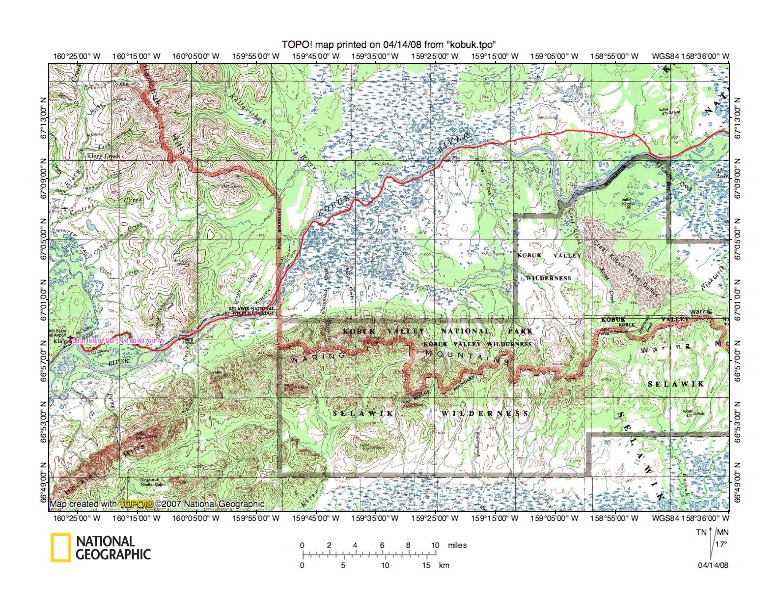
Noorvik/Kotzebue





We have a quiet Saturday morning next of John's house (Not School!). This
house has big wide window facing to the south. We can see frozen Kobuk
River. We go to drill site with John. Drill site is tundra surface with a
few spruce trees. Air temperature is a little bit cold (-5dF), it not great
temperature for drilling. We did permafrost station and frost tube taking 3
hours.
We move to Noorvik 1pm. Noorvik is hub village for trail system for
Kotzebue, Selawik, and Kiana. We pass through the way going to Selawik. We
look for Rod (Math/Science teacher). He is in the gym even on Saturday. We
are very lucky to find several students help us to install logger and frost
tube. High school student (Jerry) helps a lot all the way installation out
side of the school! Thank you Jerry!
After the establish site. We go to Kotzebue.

Friday, April 11, 2008
Kivalina
We are approaching to the final stage of this year?s snow machine trip! One
more village to go for total 24 villages in this 3 weeks trip.
The last village is Kivalina, about 90 mile north from Kotzebue. Weather is
not ideal situations for snow machine. But we heard weather turning to worse
tomorrow. We decide to go and back Kivalina one day trip. We have almost
white out. Sometimes we can see sun but sometimes not. Trail condition is
not bat. In general, we follow coastline, Kenji did this section in 1995
snowmachining from Barrow. Only concerning is open water. Many open lead is
reported near Kivalina. We should not go off shore.



We saw many wild lives the way goes up. About 3 hours later, we made it with
freezing cold by the windy gust.
Principal let us warm up and take some warm drinks.
After the warm up, we go to drill site 2 miles away. Drill is not bad and to
take 2 hours to establish permafrost station.


After drilling, we check spring site near by (the way back to Kotzebue).
After 5pm, we start head back to Kotzebue. It is getting miserable weather,
big heavy snow with wind. All of the trail is already disappeared and looks
like nobody here since last fall. Kenji tries to remember the landscape the
way coming to Kivalina this morning. Unfortunatlly, white out cannot help
his memory much.
However, 7:30pm, we see city light for Kotzebue. It was longest run (175
miles) in this trip. We cerebrate our trip at Bay Side Caffee.
